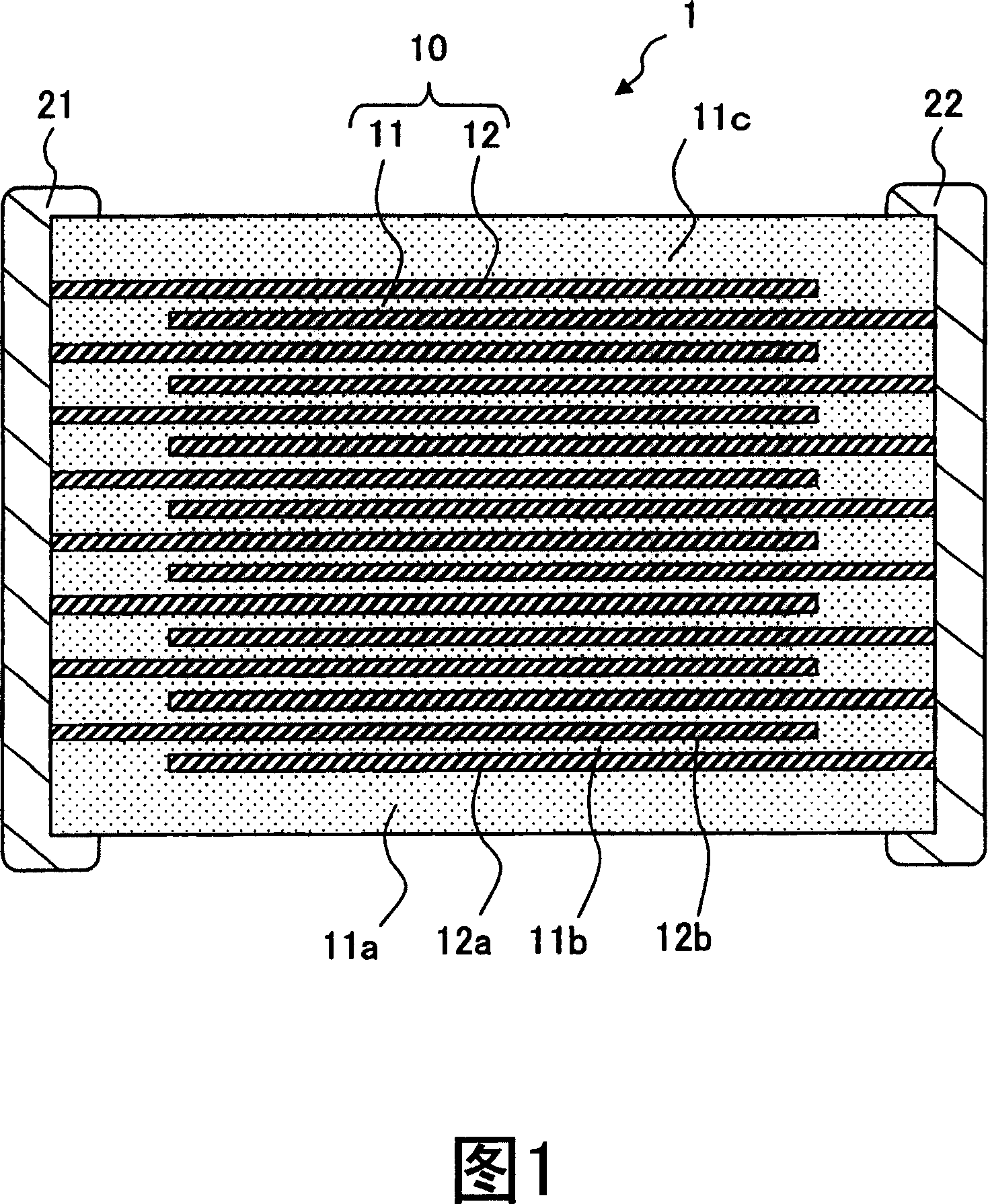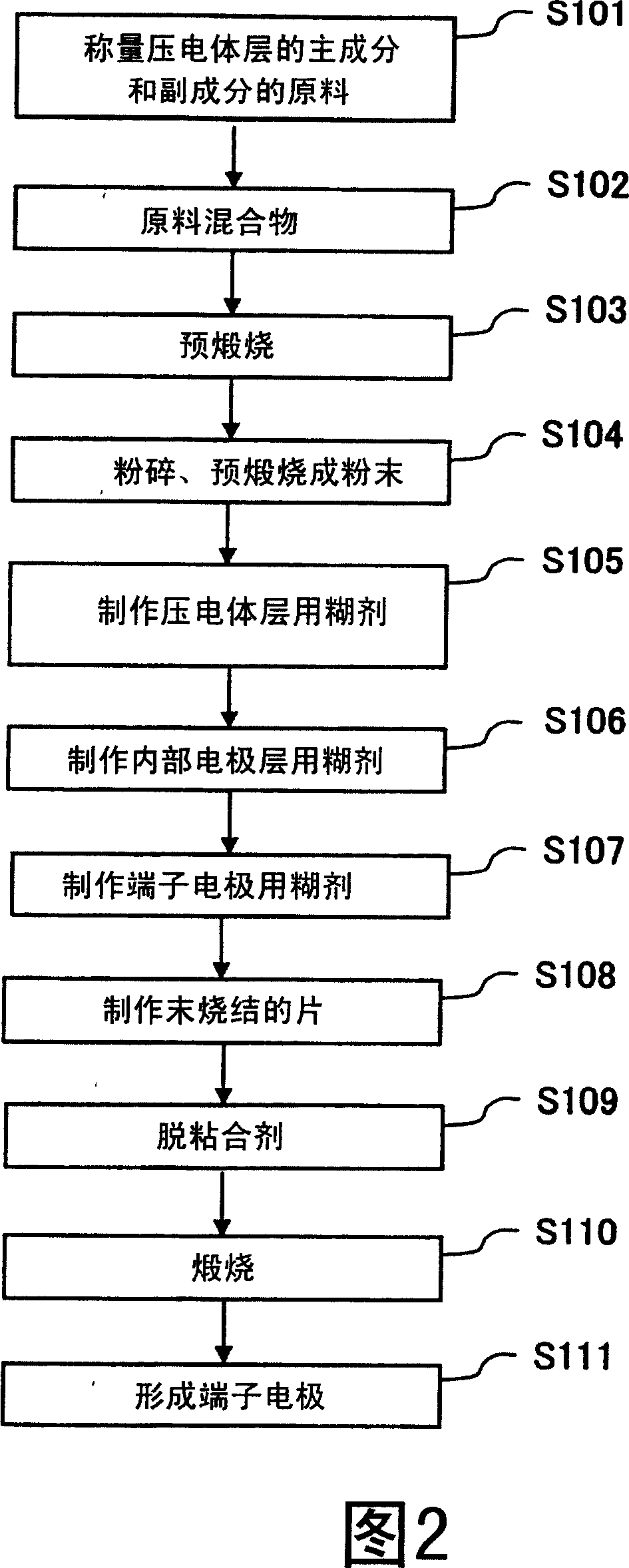Piezoelectric ceramic composition and laminated piezoelectric element
A technology of piezoelectric ceramics and piezoelectric elements, applied in the field of laminated piezoelectric elements, can solve problems such as the influence of the reliability of piezoelectric ceramic composition products
- Summary
- Abstract
- Description
- Claims
- Application Information
AI Technical Summary
Problems solved by technology
Method used
Image
Examples
Embodiment 1
[0222] An experiment for confirming the effect of adding the first subcomponent (MgO) will be described as Example 1.
[0223] In this experiment, Mg was added in the amount shown in FIG. 4 in terms of MgO with respect to the following main components, and the effect was examined.
[0224] Main component: (Pb 0.995-0.03 Sr 0.03 )[(Zn 1 / 3 Nb 2 / 3 ) 0.1 Ti 0.43 Zr 0.47 ]O 3
[0225] The piezoelectric ceramic composition was produced as follows. First, prepare PbO powder, SrCO 3 powder, ZnO powder, Nb 2 o 5 Powder, TiO 2 Powder, ZrO 2 The powder is used as the raw material of the main component, and weighed according to the composition of the above-mentioned main component. In addition, MgO was prepared as an additional species of Mg, and was added to the parent composition of the main component at the content shown in FIG. 4 . Next, these raw materials were wet-mixed for 16 hours using a ball mill, and precalcined at 700 to 900° C. in air for 2 hours.
[0226] Aft...
Embodiment 2
[0232] A sample was prepared in the same manner as in Example 1 except that a and Mg were added in the amounts shown in FIG. 7 in terms of MgO to the following main components. For the obtained sample, the electromechanical coupling coefficient kr (%) was measured in the same manner as in Example 1. The results are shown in FIG. 7 .
[0233] Main component: (Pb a-0.03 Sr 0.03 )[(Zn 1 / 3 Nb 2 / 3 ) 0.1 Ti 0.43 Zr 0.47 ]O 3
[0234] As shown in FIG. 7 , in the samples subjected to Cu paste printing, when a was in the range of 0.96 to 1.03, an electromechanical coupling coefficient kr (%) of 60% or more was obtained.
Embodiment 3
[0236] Samples were produced in the same manner as in Example 1 except that b and Mg were added in the amounts shown in FIG. 8 in terms of MgO to the following main components. For the obtained sample, the electromechanical coupling coefficient kr (%) was measured in the same manner as in Example 1. The results are shown in FIG. 8 .
[0237] Main component: (Pb 0.995-b Sr b )[(Zn 1 / 3 Nb 2 / 3 ) 0.1 Ti 0.43 Zr 0.47 ]O 3
[0238] As shown in FIG. 8 , it can be seen that the electromechanical coupling coefficient kr (%) can be increased by substituting Sr for Pb of the above-mentioned main component, and the substitution amount (molar ratio) of Sr is preferably 0.1 or less.
PUM
| Property | Measurement | Unit |
|---|---|---|
| thickness | aaaaa | aaaaa |
| particle diameter | aaaaa | aaaaa |
| thickness | aaaaa | aaaaa |
Abstract
Description
Claims
Application Information
 Login to View More
Login to View More - R&D
- Intellectual Property
- Life Sciences
- Materials
- Tech Scout
- Unparalleled Data Quality
- Higher Quality Content
- 60% Fewer Hallucinations
Browse by: Latest US Patents, China's latest patents, Technical Efficacy Thesaurus, Application Domain, Technology Topic, Popular Technical Reports.
© 2025 PatSnap. All rights reserved.Legal|Privacy policy|Modern Slavery Act Transparency Statement|Sitemap|About US| Contact US: help@patsnap.com



